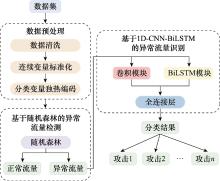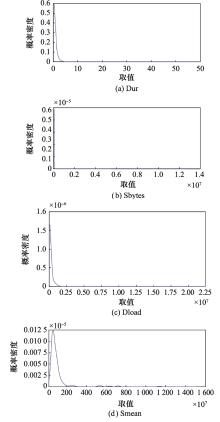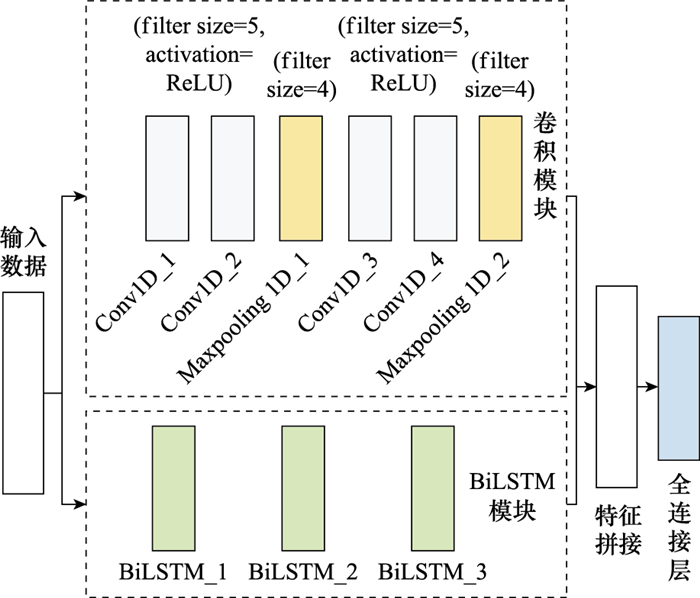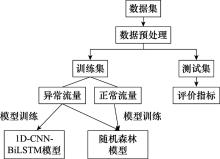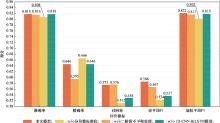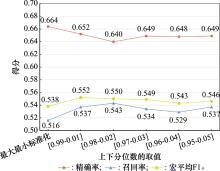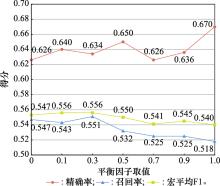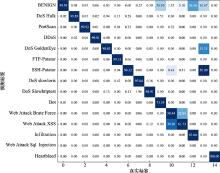Systems Engineering and Electronics ›› 2025, Vol. 47 ›› Issue (6): 2065-2075.doi: 10.12305/j.issn.1001-506X.2025.06.34
• Communications and Networks • Previous Articles
Two-stage novel method for imbalanced data distribution in network intrusion detection
Bo WEI1, Caifu HU2, Ruibin REN1,*
- 1. School of Mathematics, Southwest Jiaotong University, Chengdu 611756, China
2. School of Information Science and Technology, Southwest Jiaotong University, Chengdu 611756, China
-
Received:2024-06-21Online:2025-06-25Published:2025-07-09 -
Contact:Ruibin REN
CLC Number:
Cite this article
Bo WEI, Caifu HU, Ruibin REN. Two-stage novel method for imbalanced data distribution in network intrusion detection[J]. Systems Engineering and Electronics, 2025, 47(6): 2065-2075.
share this article
Table 2
Data distribution of CIC-IDS2017"
| 流量类型 | 流量子类型 | 数量 |
| Benign | Benign | 2 273 097 |
| Intrusion | DoS Hulk | 231 073 |
| PortScan | 158 930 | |
| DDoS | 128 027 | |
| DoS GoldenEye | 10 293 | |
| FTP-Patator | 7 938 | |
| SSH-Patator | 5 897 | |
| DoS slowloris | 5 796 | |
| DoS Slowhttptest | 5 499 | |
| Bot | 1 966 | |
| Infiltration | 36 | |
| Heartbleed | 11 | |
| Web Attack Brute Force | 1 507 | |
| Web Attack Sql Injection | 652 | |
| Web Attack XSS | 21 |
Table 2
Table 6
Results of ablation experiment"
| 模型 | 方法 | UNSW-NB2015数据集 | |||||||
| 分位数标准化 | 1D-CNN-BiLSTM | 二阶段不平衡处理 | 准确率 | 精确率 | 召回率 | 宏平均F1 | 加权平均F1 | ||
| 本文模型 | ✔ | ✔ | ✔ | 0.818 | 0.646 | 0.575 | 0.586 | 0.822 | |
| w/o二阶段不平衡处理 | ✔ | ✔ | - | 0.808 | 0.666 | 0.512 | 0.524 | 0.802 | |
| w/o 1D-CNN-BiLSTM模型 | ✔ | - | ✔ | 0.818 | 0.646 | 0.530 | 0.537 | 0.819 | |
| w/o分位数标准化 | - | ✔ | ✔ | 0.816 | 0.595 | 0.576 | 0.567 | 0.817 | |
Table 6
| 1 |
LAN J H , LIU X D , LI B , et al. A novel hierarchical attention-based triplet network with unsupervised domain adaptation for network intrusion detection[J]. Applied Intelligence, 2023, 53 (10): 11705- 11726.
doi: 10.1007/s10489-022-04076-0 |
| 2 |
THAKKAR A , LOHIYA R . A survey on intrusion detection system: feature selection, model, performance measures, appli cation perspective, challenges, and future research directions[J]. Artificial Intelligence Review, 2022, 55 (1): 453- 463.
doi: 10.1007/s10462-021-10037-9 |
| 3 |
CUI J Y , ZONG L S , XIE J H , et al. A novel multi-module integrated intrusion detection system for high-dimensional imba-lanced data[J]. Applied Intelligence, 2023, 53 (1): 272- 288.
doi: 10.1007/s10489-022-03361-2 |
| 4 |
KHAN S H , HAYAT M , BENNAMOUN M , et al. Cost-sensitive learning of deep feature representations from imbalanced data[J]. IEEE Trans. on Neural Networks and Learning Systems, 2018, 29 (8): 3573- 3587.
doi: 10.1109/TNNLS.2017.2732482 |
| 5 | 李艳霞, 柴毅, 胡友强, 等. 不平衡数据分类方法综述[J]. 控制与决策, 2019, 34 (4): 673- 688. |
| LI Y X , CHAI Y , HU Y Q , et al. Review of imbalanced data classification methods[J]. Control and Decision, 2019, 34 (4): 673- 688. | |
| 6 |
BEDI P , GUPTA N , JINDAL V . Ⅰ-SiamIDS: an improved SiamIDS for handling class imbalance in network-based intrusion detection systems[J]. Applied Intelligence, 2021, 51, 1133- 1151.
doi: 10.1007/s10489-020-01886-y |
| 7 |
潘成胜, 李志祥, 杨雯升, 等. 基于二次特征提取和BiLSTM-Attention的网络流量异常检测方法[J]. 电子与信息学报, 2023, 45 (12): 4539- 4547.
doi: 10.11999/JEIT221296 |
|
PAN C S , LI Z X , YANG W S , et al. Anomaly detection method of network traffic based on secondary feature extraction and BiLSTM-attention[J]. Journal of Electronics & Information Technology, 2023, 45 (12): 4539- 4547.
doi: 10.11999/JEIT221296 |
|
| 8 | LAN Y, TRUONG-HUU T, WU J, et al. Cascaded multi-class network intrusion detection with decision tree and self-attentive model[C]//Proc. of the IEEE International Conference on Data Mining Workshops, 2022. |
| 9 | DENNING D E . An intrusion-detection model[J]. IEEE Trans. on Software Engineering, 1987, 13 (2): 222- 232. |
| 10 | PORRAS P A, KEMMERER R A. Penetration state transition analysis: a rule-based intrusion detection approach[C]//Proc. of the 8th Annual Computer Security Application Conference, 1992: 220-229. |
| 11 | SHEU T F, HUANG N F, LEE H P. NIS04-6: a time-and memory-efficient string matching algorithm for intrusion detection systems[C]//Proc. of the IEEE Global Communications Conference, 2006. |
| 12 | PAN Z S, LIAN H, HU G Y, et al. An integrated model of intrusion detection based on neural network and expert system[C]// Proc. of the 17th IEEE International Conference on Tools with Artificial Intelligence, 2005. |
| 13 | LUNT T F, JAGANNATHAN R. A prototype real-time intrusion-detection expert system[C]//Proc. of the IEEE Symposium on Security & Privacy, 1988. |
| 14 | GU J , LU S . An effective intrusion detection approach using SVM with naive Bayes feature embedding[J]. Computers & Security, 2021, 103, 102158. |
| 15 | GUEZZAZ A , BENKIRANE S , AZROUR M , et al. A reliable network intrusion detection approach using decision tree with enhanced data quality[J]. Security and Communication Networks, 2021, 2021, 123059. |
| 16 | AZIZJON M, JUMABEK A, KIM W. 1D CNN based network intrusion detection with normalization on imbalanced data[C]//Proc. of the International Conference on Artificial Intelligence in Information and Communication, 2020: 218-224. |
| 17 |
TIAN Q T , HAN D Z , LI K C , et al. An intrusion detection approach based on improved deep belief network[J]. Applied Intelligence, 2020, 50, 3162- 3178.
doi: 10.1007/s10489-020-01694-4 |
| 18 |
FOTIADOU K , VELIVASSAKI T H , VOULKIDIS A , et al. Network traffic anomaly detection via deep learning[J]. Information, 2021, 12 (5): 215.
doi: 10.3390/info12050215 |
| 19 | LIN T Y, GOYAL P, GIRSHICK R, et al. Focal loss for dense object detection[C]//Proc. of the IEEE International Conference on Computer Vision, 2017: 2980-2988. |
| 20 | DING D F, ZHU L, XIE J Y, et al. In-vehicle network intrusion detection system based on Bi-LSTM[C]//Proc. of the 7th International Conference on Intelligent Computing and Signal Processing, 2022: 580-583. |
| 21 | MOUSTAFA N, SLAY J. UNSW-NB15: a comprehensive data set for network intrusion detection systems (UNSW-NB15 network data set)[C]//Proc. of the Military Communications and Information Systems Conference, 2015. |
| 22 | SHARAFALDIN I, LASHKARI A H, GHORBANI A A. Toward generating a new intrusion detection dataset and intrusion traffic characterization[C]//Proc. of the International Con-ference on Information Systems Security & Privacy, 2018: 108-116. |
| 23 |
AL-TURAIKI I , ALTWAIJRY N . A convolutional neural net work for improved anomaly-based network intrusion detection[J]. Big Data, 2021, 9 (3): 233- 252.
doi: 10.1089/big.2020.0263 |
| 24 |
HALBOUNI A , GUNAWAN T S , HABAEBI M H , et al. CNN-LSTM: hybrid deep neural network for network intrusion detection system[J]. IEEE Access, 2022, 10, 99837- 99849.
doi: 10.1109/ACCESS.2022.3206425 |
| 25 |
UDAS P B , KARIM M E , ROY K S . SPIDER: a shallow PCA based network intrusion detection system with enhanced recurr ent neural networks[J]. Journal of King Saud University-Computer and Information Sciences, 2022, 34 (10): 10246- 10272.
doi: 10.1016/j.jksuci.2022.10.019 |
| 26 |
REH H J , TANG Y H , DONG W Y , et al. DUEN: dynamic ensemble handling class imbalance in network intrusion detection[J]. Expert Systems with Applications, 2023, 229, 120420.
doi: 10.1016/j.eswa.2023.120420 |
| [1] | Amin DUAN, Zhaohui ZHANG. Quadratic decomposition-based cellular traffic prediction with hybrid neural network [J]. Systems Engineering and Electronics, 2025, 47(5): 1687-1697. |
| [2] | Kai CHEN, Deping ZHANG. Missile temporal planning method based on graph neural network [J]. Systems Engineering and Electronics, 2025, 47(3): 862-870. |
| [3] | Weihong FU, Xinyu ZHANG, Naian LIU. Single-channel blind source separation algorithm for co-frequency and co-modulation based on multi-scale fusion neural network [J]. Systems Engineering and Electronics, 2025, 47(2): 641-649. |
| [4] | Yongqi SHAO, Lihua YANG, Ao CHANG, Lulu REN. Time-varying channel estimation in RIS-assisted OFDM system [J]. Systems Engineering and Electronics, 2025, 47(1): 324-331. |
| [5] | Xiaobin LI, Dong XU, Xue YANG. Trajectory tracking control with predefined dynamic performance for underactuated autonomous underwater vehicle [J]. Systems Engineering and Electronics, 2024, 46(9): 3185-3197. |
| [6] | Tianqi ZHANG, Zongfang YANG, Han ZOU, Kunran MA. Blind identification algorithm for polarization code parameters based on encoding matrix estimation [J]. Systems Engineering and Electronics, 2024, 46(9): 3221-3230. |
| [7] | Lei WANG, Jin ZHANG, Qiuxuan YE. Spectrum sensing method based on cyclic spectrum and residual neural network in LDACS system [J]. Systems Engineering and Electronics, 2024, 46(9): 3231-3238. |
| [8] | Ruibin ZHANG, Mengtao ZHU, Yunjie LI. Radar transmitting signal generation method for modulation recognition network stealth [J]. Systems Engineering and Electronics, 2024, 46(7): 2256-2268. |
| [9] | Bing QI, Jianhua CHENG, Yanchi ZHAO, Zili WANG. Precise temperature drift error estimation method for capacitive MEMS accelerometers based on micro-deformation analysis [J]. Systems Engineering and Electronics, 2024, 46(7): 2437-2445. |
| [10] | Weiyi WU, Yunxian JIA, Xiangzheng JIANG, Xianming SHI, Jie LIU, Bin LIU, Enzhi DONG, Xi ZHU. Method for determining for carrying material varieties of stage task [J]. Systems Engineering and Electronics, 2024, 46(6): 2054-2064. |
| [11] | Hao QING, Zhigeng FANG, Yuhong WANG, Xirui QIU. Combination prediction of civil aircraft demand based on grey-neural network [J]. Systems Engineering and Electronics, 2024, 46(5): 1665-1672. |
| [12] | Zongfang YANG, Tianqi ZHANG, Kunran MA, Han ZOU. Blind identification of channel coding types based on deep neural networks [J]. Systems Engineering and Electronics, 2024, 46(5): 1820-1829. |
| [13] | Tong HE, Qing LU, Jun ZHOU, Zongyi GUO. Line-of-sight angle constraint guidance with neural network interference observer [J]. Systems Engineering and Electronics, 2024, 46(4): 1372-1382. |
| [14] | Hongjin ZHOU, Hui SONG, Wenliang FAN, Su WANG, Dongliang GU. Ship inertial navigation system position correction method based on Bayesian neural network [J]. Systems Engineering and Electronics, 2024, 46(4): 1393-1400. |
| [15] | Xianpeng MENG, Limin LIU, Jian DONG, Li WANG, Wenhua HU. Radar frequency agility behavior recognition based on bi-cell recurrent neural network [J]. Systems Engineering and Electronics, 2024, 46(3): 898-905. |
| Viewed | ||||||
|
Full text |
|
|||||
|
Abstract |
|
|||||
